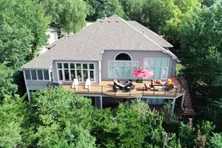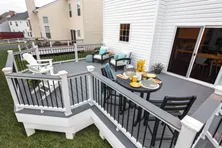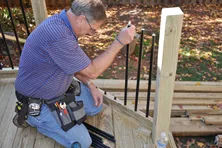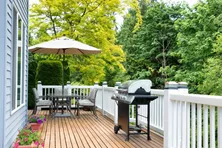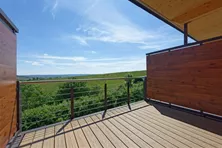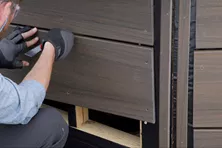When to Choose Steel vs Aluminum Deck Railings
When it comes to enhancing your deck, balcony or other outdoor spaces, you can’t go wrong with either a steel or aluminum railing. Both are popular options, each with its own advantages and considerations. Whether you're a homeowner, contractor or DIY enthusiast, this guide will help you understand the key differences between them. In this article, we'll compare aluminum to standard steel, not stainless steel, which is more commonly found in commercial applications.
Which Railing Is Better—Steel or Aluminum?
The answer depends on your specific needs and environment. Steel railings are strong, and they're cost effective up front, but they will require more maintenance in damp environments. Aluminum railings are lightweight, require little maintenance, and are naturally corrosion resistant. While steel and aluminum railings both have their merits and ideal uses, you'll have to balance many factors to make your choice. Let’s take a closer look.
Durability and Strength
Steel railings are widely recognized for their exceptional strength and resilience, making them an excellent choice for high-traffic areas, commercial applications, and any setting that requires load-bearing capacity. However, one drawback of steel is its susceptibility to rust, especially in wet, humid or coastal environments. If you don't prevent the spread of rust with regular maintenance, it could weaken the structure, leading to potential safety hazards and costly repairs.
Aluminum is naturally resistant to corrosion, making it an ideal material for locations with high moisture levels, such as coastal or rainy climates. It's significantly lighter than steel, yet it still offers excellent structural integrity for most residential applications. However, aluminum is more susceptible to dents or bending if subjected to excessive force or impacts.
Maintenance Requirements
When properly maintained, steel railings can last for decades, a lifespan that will match or exceed the life of most decks. However, regular maintenance is crucial to prevent rust and deterioration. As with any style of railing, you’ll need to clean steel railings with soap and water a couple of times a year. In addition to cleaning, the occasional touchup coat of paint will likely be required. The frequency of these additional coatings could range from every three years in wet climates to eight years or longer in dry regions. Neglecting this upkeep could compromise the safety and appearance of the railing and add to long-term maintenance costs. However, regardless of the region, steel is more stable and less affected by moisture than wood. Therefore, compared with wood, steel is a great low-maintenance choice.
Aluminum railings require very little maintenance, making them an attractive choice for anyone looking for a low-upkeep option. Powder-coated aluminum railings don't rust, and their finish requires only occasional washing to remove dirt or debris. While powder coating is highly durable, it can chip if subjected to sharp impacts. And as with all coated building materials, the paint on aluminum railings will fade over time.
Steel Railing Installation
Transporting and handling heavy steel railing is more difficult, because unlike aluminum railing, which is packaged in kits, steel railing is sold in preassembled 6- and 8-ft. sections. The upside is that less assembly is required. While the post bracket hardware and bracket installation steps for steel and aluminum are similar, steel railing panels require special metal-cutting blades to trim them to size.
Even hidden cut ends must be coated with paint to prevent rust from forming. Steel provides a rock-solid structure once installed, but the additional weight and bulkiness make it a two-person job and less practical for beginning DIY enthusiasts.
Aluminum Railing Installation
Aluminum railing panels, by contrast, are sold in lightweight, easy-to-handle kits. Aluminum railing requires more assembly than steel, but they are easy to install, making them a good choice for capable DIYers. Aluminum is a softer metal that can often be cut with the same saw blades used to cut wood, and cut ends hidden behind brackets or other hardware don't need a protective coating of paint to prevent corrosion.
You should always wear eye protection when cutting building materials, and it's especially important when cutting any type of metal. Metal shavings in the eye can cause permanent damage.
Cost Considerations
Steel railings are less expensive than aluminum, which makes them a cost-effective choice at the time of purchase. However, the long-term value of steel railing needs to be weighed against the occasional painting required. Aluminum is more expensive up front but it can prove to be cost efficient over time. With its durable powder-coated paint and corrosion resistance, aluminum requires minimal maintenance and results in lower long-term expenses. Also, the ease of installation makes aluminum a timesaving option for DIYers and a money-saving option if you have your railing installed by a pro.
Aesthetic Appeal of Steel
Steel railings offer a bold, industrial and timeless look that appeals to many homeowners and designers. The solid structure and sleek appearance work well with both classic and contemporary designs. The primary difference between the appearance of steel and aluminum railing is that due to its superior strength, the top and bottom rails can be made narrower, and a railing section can span longer without the need for a mid-span support foot below the bottom rail. However, compared with options like wood and composite, steel and aluminum deliver a similar aesthetic.
Aesthetic Appeal of Aluminum
When it comes to the appearance of your railing, one main advantage of aluminum is its design flexibility. Aluminum offers a variety of colors. This allows homeowners to customize their railing system to match various architectural styles and personal preferences. Aluminum railings also accommodate a much larger range of infill options. Aluminum posts and top and bottom rails can be paired with infill options such as hog wire, mesh, horizontal rods, stainless steel cables or glass.
Frequently Asked Questions
Are Trex® Aluminum Railings Eco-Friendly?
Yes, Trex aluminum railings are eco-friendly. Trex is committed to sustainability, and its aluminum railings are made from recycled materials, making them an environmentally responsible choice.
Which Type of Railing Is Most Suitable for Coastal Regions?
Aluminum railings are highly suitable for coastal regions because of their corrosion resistance and ability to withstand salt exposure.
Which Steel Is Best for Outdoor Railing?
Stainless steel is the best option for outdoor railings because of its resistance to rust and corrosion. However, this benefit comes at a much higher cost than regular steel or aluminum.
Can I Install Aluminum Railings Myself?
Aluminum railings are lightweight and easy to handle, making them a great option for DIY installation. However, if you’re unsure about structural requirements, consult a professional.
How Long Do Aluminum Railings Last Compared with Steel Railings?
Aluminum railings typically last longer than steel railings in most climates, especially in wet or coastal areas.
Which Trex Product has a Longer Warranty?
The warranty on Trex Select™ and Signature® Aluminum Railings are 25 and 50 years, while Trex Steel Railings are guaranteed for 15 years. This longer warranty reflects aluminum's superior resistance to corrosion and lower maintenance needs over time. If long-term peace of mind is the main priority, aluminum offers the better value in terms of product protection.
Can I Paint or Refinish Aluminum Railings?
Trex aluminum railings are expertly powder-coated for lasting durability and a premium finish—no painting required. In fact, painting or refinishing the railing is not recommended, as it can compromise the protective coating and void your warranty.
Are Trex Railings Compatible with Other Decking Materials?
Yes, Trex railings are designed to be compatible with a variety of decking materials, including wood and composite.
How Do I Clean and Maintain Trex Aluminum Railings?
Cleaning Trex aluminum railings is simple. Use a mild soap and water solution to remove dirt and debris. Avoid abrasive cleaners or tools that could damage the powder-coated finish.
What Color Options Do Trex Metal Railings Offer?
Steel is available in black, while aluminum comes in black, bronze and white.
Learn More about Railings
Visit the links below to learn more about how to choose, build, and maintain your new railing.
Glass Deck Railing Ideas and DIY Installation Tips
All glass panels used for deck railings must be safety-tempered and shatter-resistant. Learn how to install glass railing panels and get ideas for your deck.
Low-Maintenance Composite Deck Railing Options
Composite railing systems offer a low-maintenance alternative to traditional wood railings. Learn why composite is the best railing system at Decks.com.
Balusters
Step-by-step instructions on installing deck rail balusters. Learn how to install metal balusters with connectors.
Deck Skirting
Skirting can be an attractive feature that can be added to any low-level deck.
What Does it Cost to Build a Second Story Deck?
Interested in an elevated deck but asking yourself how much does a second story deck cost? Learn the cost to build a second story deck here.
Covered Deck Costs
Interested in a covered deck but asking yourself how much it costs? Learn the cost to build a covered deck depending on types of deck covers and add-ons.
More Helpful Resources
Explore Articles by Topic
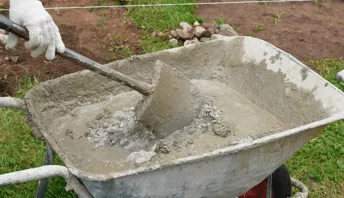
Footings
Information related to installing frost footings for decks
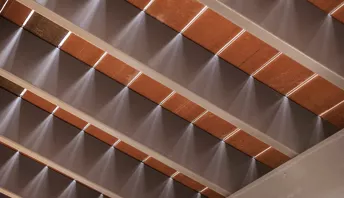
Framing
Learn structural framing methods

Decking
Learn about wood and composite decking materials
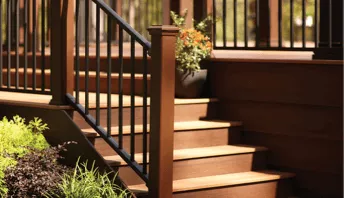
Stairs
An in-depth look at the complex issue of how to build stairs
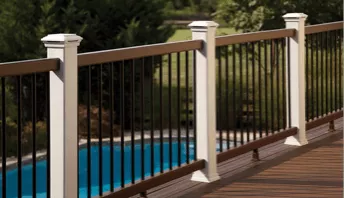
Railings
How to install guardrails and handrails to meet IRC code
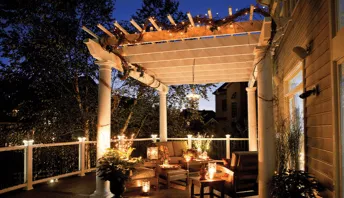
Features
An overview on water drainage, benches, planters and lights

Design
The basics of deck design
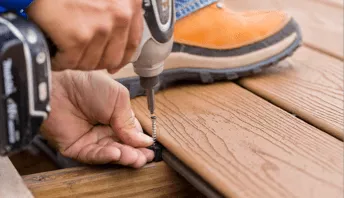
Planning
Learn about permits and working with contractors
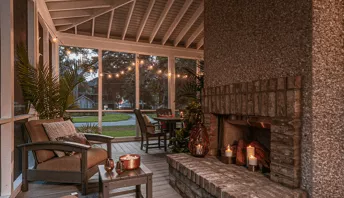
Porches & Patios
Build a covered deck to enjoy all seasons
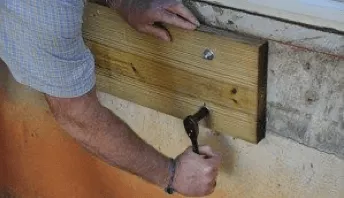
Ledger
Proper attachment techniques
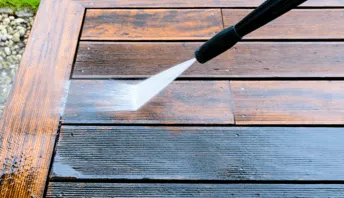
Care
Maintain your deck to maintain your investment
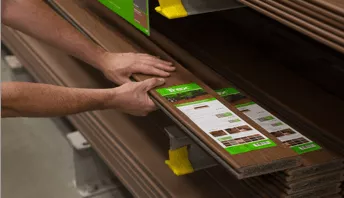
Materials
An overview on water drainage, benches, planters and lights
Deck Railing Safety for the Whole Family
Make your deck safe for everyone who uses it. Follow this expert advice on deck railing installation, maintenance and safety features to prevent falls and hazards
Vinyl Deck Railing Reviews, Comparisons, & Costs
Compare Vinyl Deck Railings to wood, aluminum, and composite. Find reviews and cost information to help choose the best deck railing for your home at Decks.com.
How to Build a Deck Privacy Screen
In some deck design situations, you may feel that it is important to block certain views to increase privacy. This can usually be achieved by building a privacy wall or fence.
5 Best Ways on How to Hide Trash Cans Outside
Outdoor trash cans can be an unwanted eyesore. Discover how you can easily cover them up and add an extra touch of beauty to your yard.
Deck Skirting Ideas
Deck skirting offers more than aesthetics. From added storage to critter deterrence and concealing structures, explore our top ideas for your backyard's transformation.
The Top 10 Outdoor Fireplaces for 2025
Outdoor fireplaces can make your deck or patio cozy year round. Get our recommendations for how to choose the best outdoor fireplace.
Explore Articles by Topic

Footings
Information related to installing frost footings for decks

Framing
Learn structural framing methods

Decking
Learn about wood and composite decking materials

Stairs
An in-depth look at the complex issue of how to build stairs

Railings
How to install guardrails and handrails to meet IRC code

Features
An overview on water drainage, benches, planters and lights

Design
The basics of deck design

Planning
Learn about permits and working with contractors

Porches & Patios
Build a covered deck to enjoy all seasons

Ledger
Proper attachment techniques

Care
Maintain your deck to maintain your investment

Materials
An overview on water drainage, benches, planters and lights








